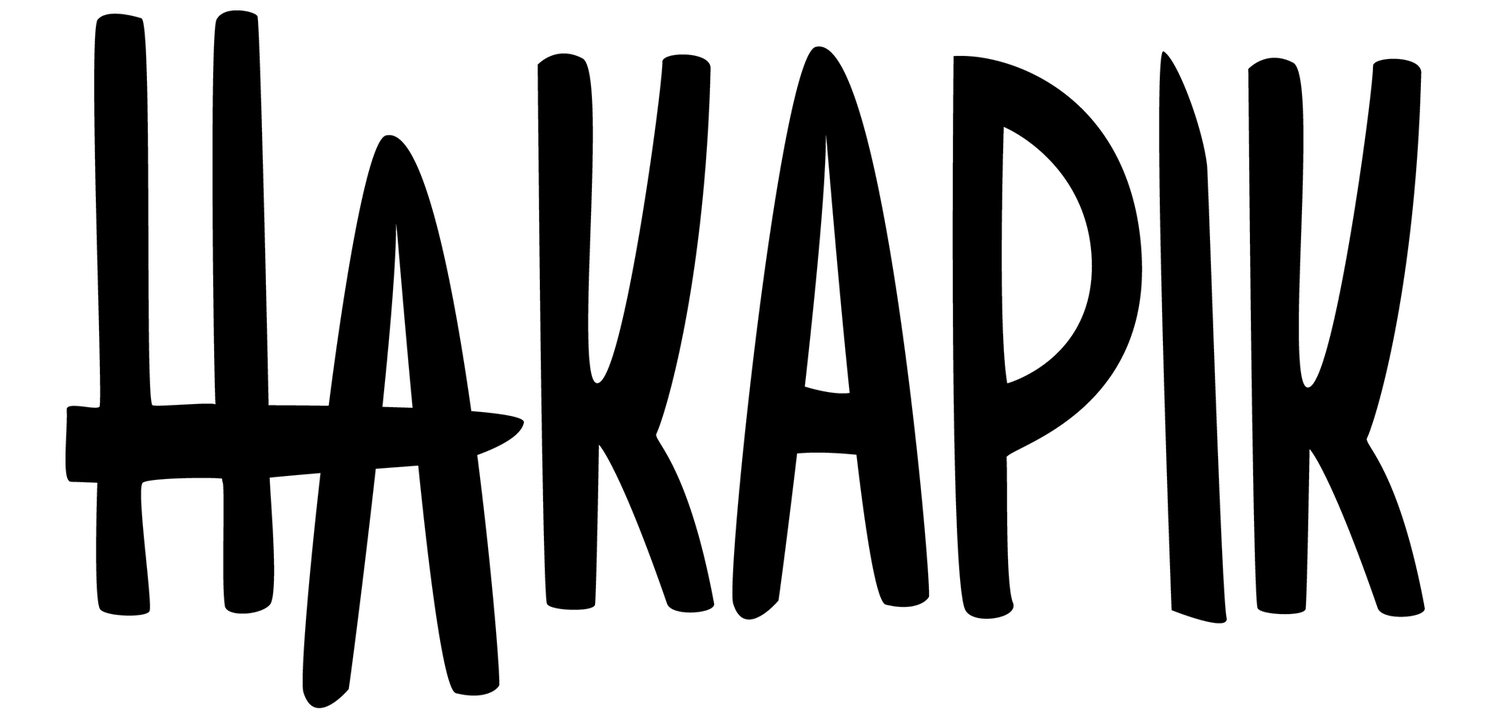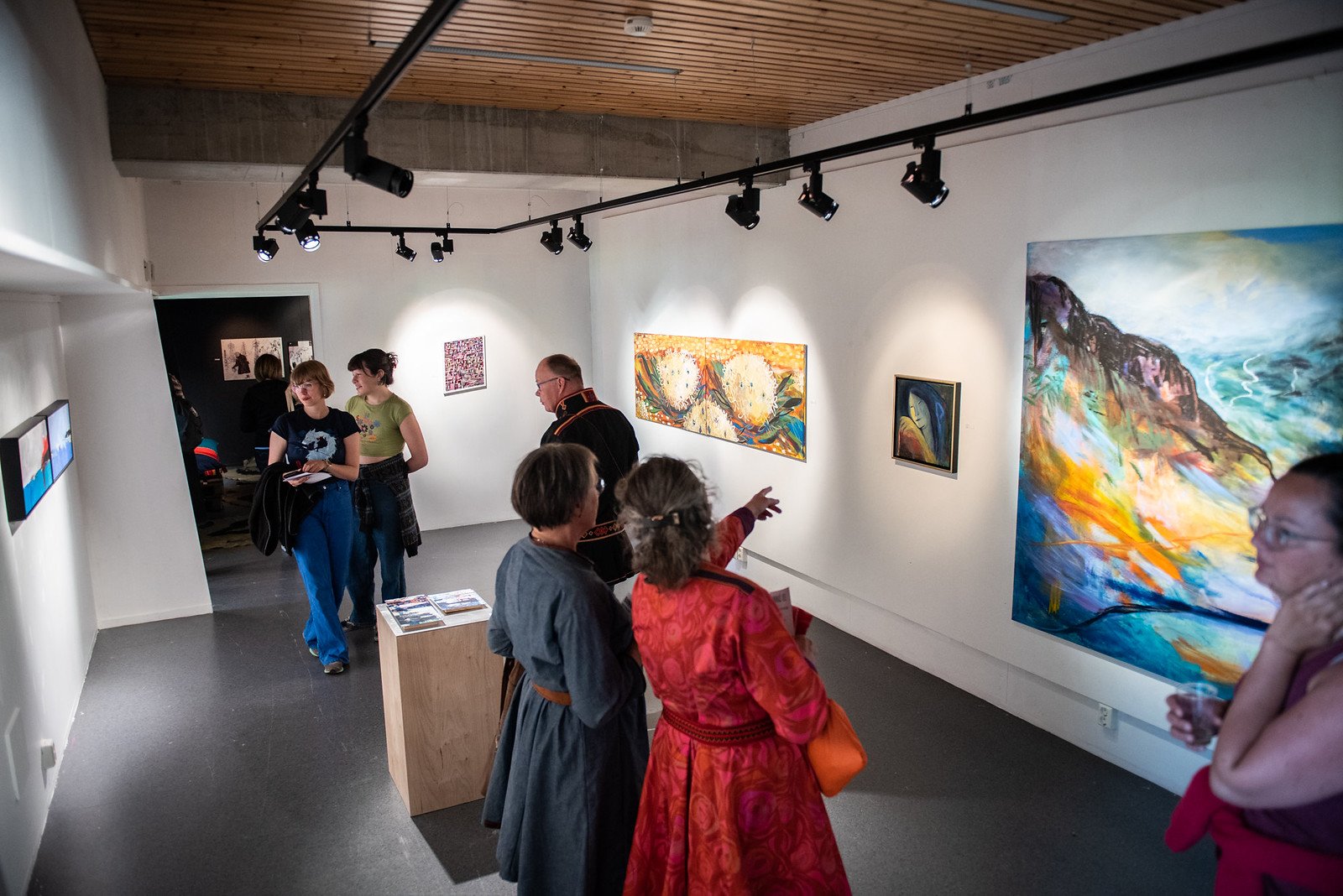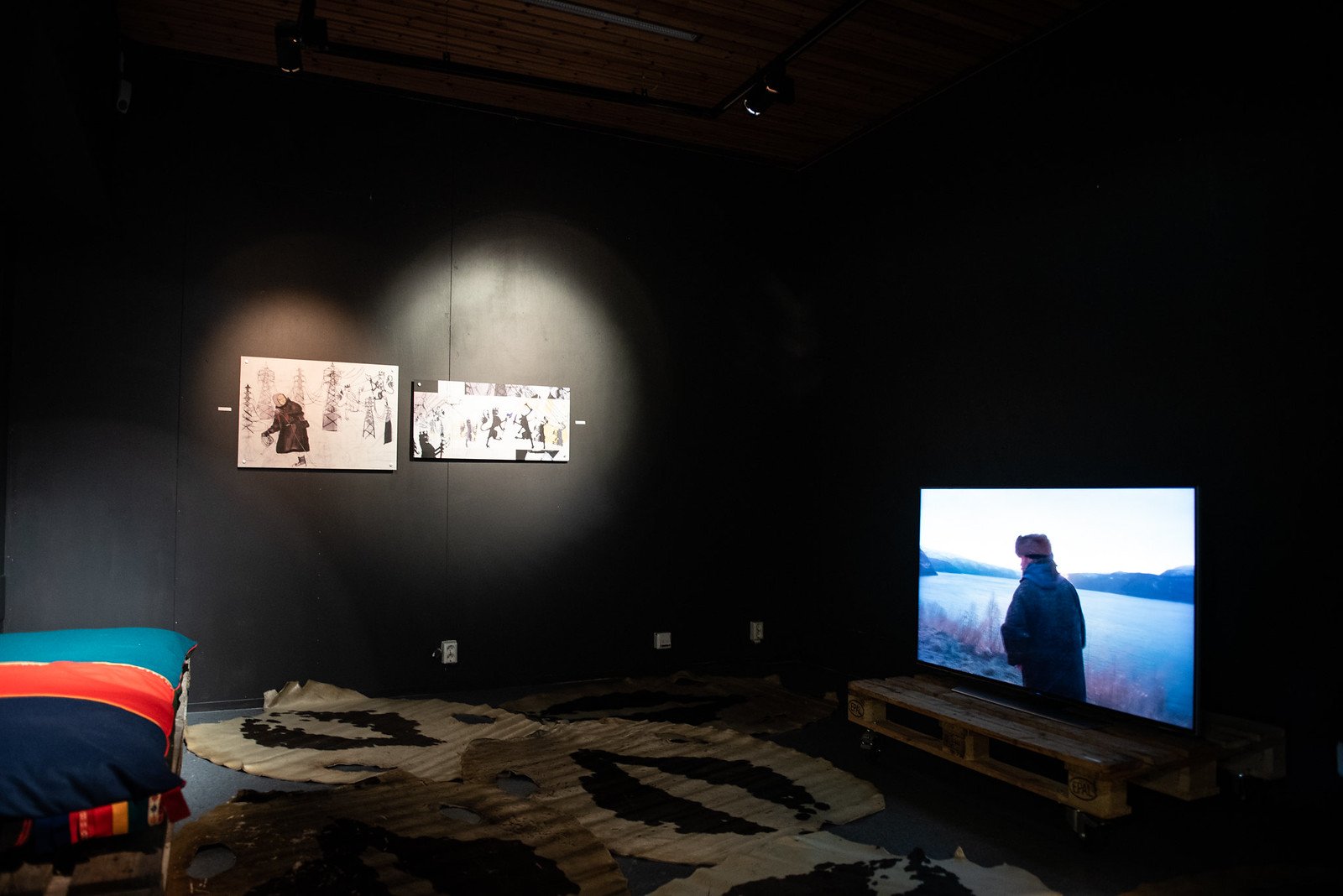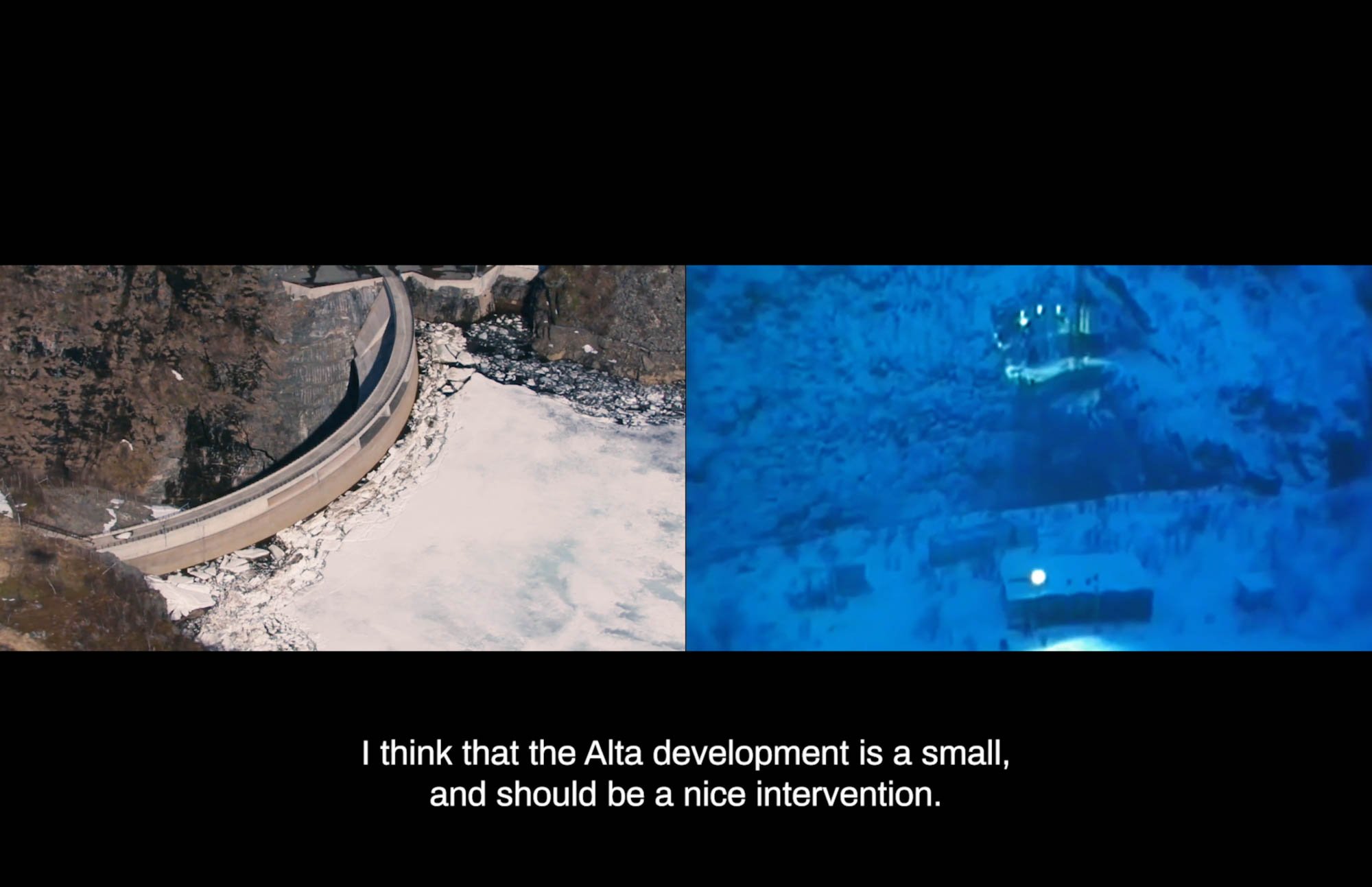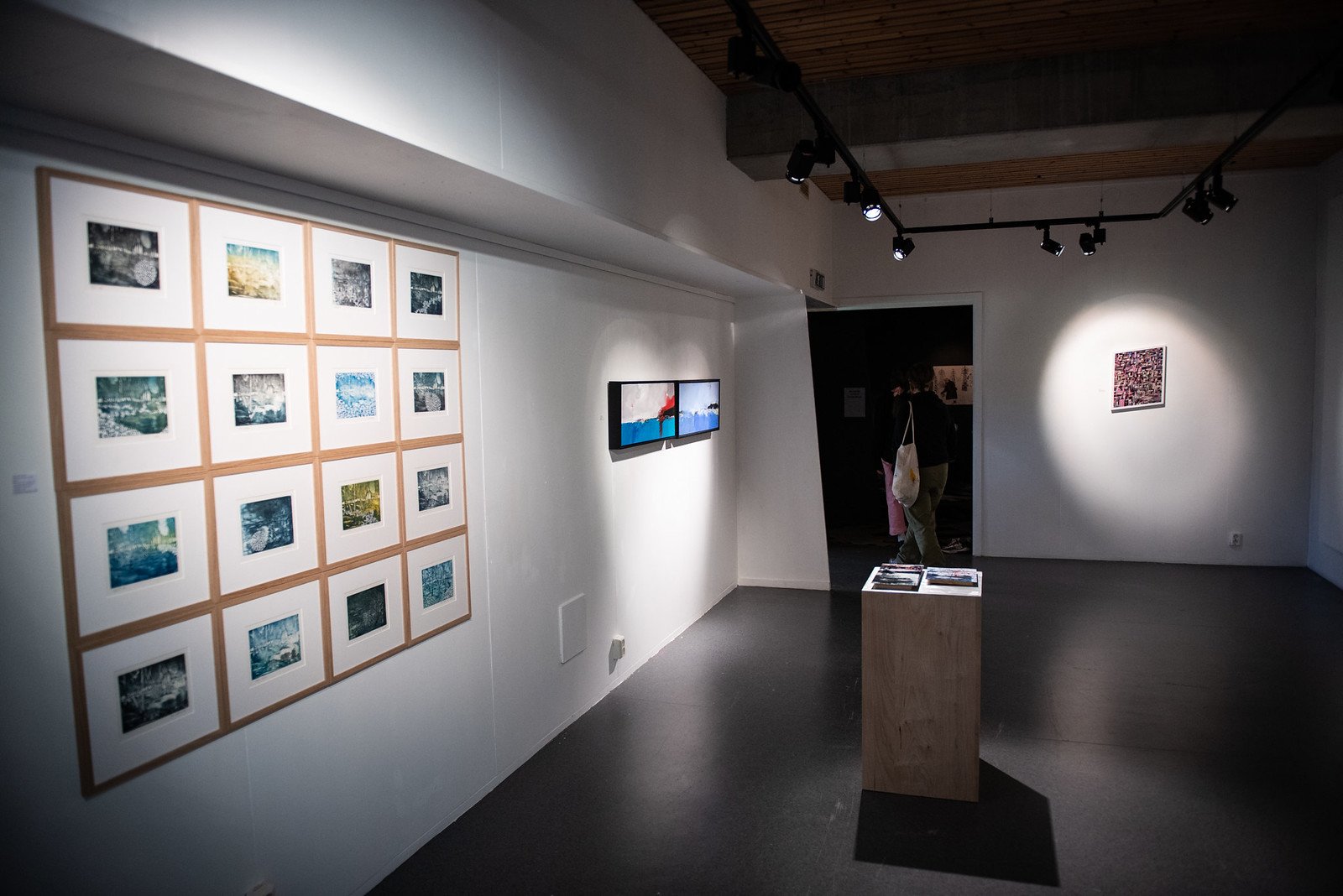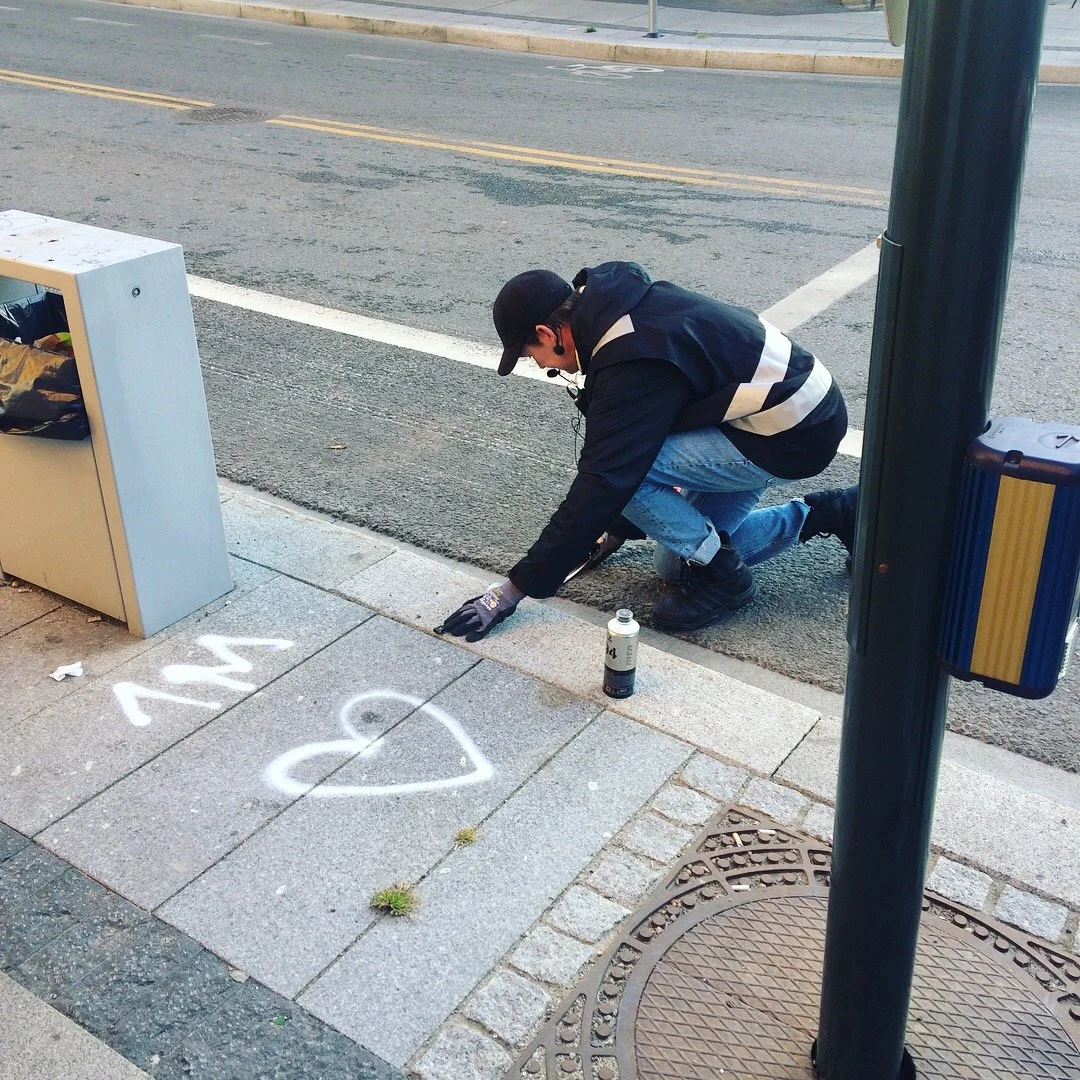Hard-hitting content, vague shape / Deaivilis sisdoallu, geamus hápmi
Translated into northern sami by Johan Daniel Hætta. The translation was added to the page December 22, 2022, and is sponsored by Troms og Finnmark Fylkeskommune.
Review of the festival exhibition Binnáš vel! part of Riddu Riđđu Festivála 2022, Davvi Álbmogiid Guovddáš (center for northern people). Curated by Gry Spein, Sandra Márjá West and Leif Magne Tangen. Kåfjord, 13.07.22 - 02.09.22.
Binnáš vel is an exhibition composed of such quality artworks that it is highly worth seeing. At the same time, the proposed curatorial topic –although certainly interesting– fails to encompass all the works, while also feeling quite vague.
The title of the exhibition, “Binnáš vel!”, is borrowed from a northern Sámi expression meaning “Just a little bit more.” According to the exhibition description, it refers to the land predation of governments and corporations, who relentlessly ask Indigenous people to give “just a little bit more” of their lands and waters. This theme is best addressed in the collection of short films screened at the cozy, wood-paneled Nisga'a Longhouse during the festival and that forms part of the exhibition. Taking us from the Norwegian side of Sápmi to its Finnish side by way of Greenland, this short film program impresses by the quality and relevance of the works presented, which shed light on issues around mining, waste management and access to land on Indigenous territories.
Sámi rights under attack, past and present
The three films composing the documentary film program –Duhát jagi (2022) by the collective Ellos Deatnu, In the Shadow of the Tugtupite (2020) from Inuk Jørgensen of Kalaallit Nunaat/Grenland and Elina Waage Mikalsen and Magnus Holmen’s film Geaidnoearus / Ved Veiskillet (2022) – are enlightening and well-made. The latter is particularly worth watching.
Waage Mikalsen and Holmen uses a split screen to put in echo the recent activist movement against the Norwegian government’s plan to use Repparfjord as a landfill for mining waste, and the 1981’s historical protests against the construction of a hydroelectric power plant on the Guovdageainnu-Álttá (Kautokeino-Alta) river. Despite the controversy, the power station was completed in 1987. Nonetheless, the Alta protests made history for being one of the most followed acts of civil disobedience lasting from 1978 to 1982 putting Sámi rights on the forefront of the political agenda, and for associating Sámi activities with environmental groups from all over Norway.
The comparison that Waage Mikalsen and Holmen draw with the recent Repparfjord scandal is all the more interesting since the issue is still unsettled. Similarly to the Alta protests, the case of Repparfjord has been led by Sámi activists who have been joined by environmental activists: the fjord into which mining waste would be dumped is known for hosting large amounts of salmon, as well as being spawning grounds for cod, and has traditional and practical use for local Sámi reindeer herders.
Associating recent images shot around Repparfjord with interviews of activists and locals in voiceover and archival footage from the Alta protests, Geaidnoearus / Ved Veiskillet stands out as a political and artistic testimony to the continuous violations of Sámi rights at the hands of the Norwegian government. It is also a poetic evocation of the activist fight for Indigenous rights and for the environment.
Strong voices, too little space
Back at the Senter for Nordlige Folk, where most of the artworks are displayed, we walk among old and new installations, photos, collages, paintings and sculptures. The curators can be praised for associating big names like Outi Pieski and Josef Halse, with younger, exciting artists such as Marte Lill Somby and Riddu Riđđu’s Young Artist of the Year, Márjá Karlsen. The latter’s impressive installation blends traditional weaving with “stream of consciousness”-like expressions. Then there is also Jenni Laiti’s text Å leve som et godt menneske / Eallit olmmožin which is strikingly clear and hard-hitting. Each work in the exhibition has a lot to offer on its own, and altogether there is a sort of chaotic harmony that makes the works look good as an ensemble.
Yet, I felt a longing for greater dialogue between the different pieces, which could have been brought about by narrowing the topic behind the exhibition, or by providing additional elements of context to the works. Considering the scope of both the thematic and the number of works, I also found myself wondering if this gallery space was really a good fit: the three successive narrow rooms did not really provide enough breathing and contemplation space for an exhibition of this ambition, and some works ended up fading in the background. That is the case of the stunning collage by Katarina Pirak Sikku, as well as Máret Ánne Sara’s two mixed-media prints, which were difficult to appreciate when placed in the same – and quite dark – room in which Joar Nango and Ken Are Bongo’s very interesting tv-series Post-Capitalist Architecture-TV was playing on loop.
But after all, Binnáš vel! boasts more than 20 participating artists and filmmakers who together compose a remarkable picture of what Sámi art has to offer.
Geahčadeapmi “Binnáš vel!” čájáhusa Riddu Riđus festiválas 2022. Davvi Álbmogiid Guovddážis. Kuráhtorat leat leamašan Gry Spein, Sandra Márjá West ja Leif Mange Tangen, Gáivuonas 13.07.22 -02.09.22.
“Binnáš vel!” lea čájáhus mii lea hábmejuvvon nu ahte dáidagiid lea duođai veara geahččat. Seammás fáttát mat čájehuvvojit – vaikko leat albma gelddolaččat – fátmmastit buot dáidagiid, seammás go orrot oalle geamus.
Marion Bouvier bokte
Čájáhusa namma “Binnáš vel”, lea luoikkahuvvon sámegielas. Čájáhusčilgehusas boahtá diet eananrievidemiin maid ráđđehusat ja fitnodagat bivdet álgoálbmogis ahte addit “binnáš vel sin eatnamiin ja čázadagain. Fáddá čuvgejuvvo buoremusat oanehis filmmaid bokte mat čájehuvvojit festiválas dan liekkus muorraviesus Nisga’a Longhouse, mii maid lea oassin čájáhusas. Dát oanehisfilbma prográmma doalvu min Norgga beale Sámis Suoma beale Sápmái gitta Ruonáeatnamii, ja dáidagat hirbmat bures fuomášahttet ja guoskkahit áššiid ruvkedoaimmaid birra nuoskkideami birra ja álgoálbmogiid eanangeavaheami birra.
Sámiid vuoigatvuođat fallehuvvojit, ovddešáigi ja dálá áigi
Diet golbma dokumentárafilmma mat dahket – Duhát jagi (2022), joavkku Ellos eatnu bokte; In the Shadow of the Tugtupite (Tugtupite suoivvanis) (2020), Inuk Jørgensen bokte, Kalaallit Nunaat/Ruonáeatnamis eret; ja Geaidnoearus (2022), Elina Waage Mikalsen ja Magnus Holmen bokte - čuvgejit fáttá ja leat bures ráhkaduvvon. Earenoamážit maŋemus namuhuvvon lea veara oaidnit.
Waage Mikalsen ja Holmen geavaheaba juogaduvvon šearpma vai bures oaidná movt aitto vuođđuduvvon vuostálastijoavku bargá Norgga ráđđehusa plánaid vuostá ahte ruvkeruskkaid bidjat Riehpovutnii, ja buohtastahttá historjjálaš vuostálastimiid 1981 Guovdageainnu-Áltá eanu buođđumiin. Vaikko ledje vuosttildeamit, de goit ge elfápmorusttet gárvvistuvvui 1987. Áltá vuostálastimat historjjálaččat go diet leat daid siviilla jeagohisvuođaid gaskkas maid buot eanemusat leat čuvvojuvvon dáhpáhusat ja biste 1978 rájes gitta 1982 rádjái. Diet vuostálastimat fuomášuhtte sámiid vuoigatvuođaid politihkalaččat, ja čatne oktii sámiid doaimmaid ja birasjoavkkuid miehtá Norgga.
Buohtasteapmi maid Waage Mikalsen ja Holmen dahkaba Riehpovuona skandálain, lea hui gelddolaš go ášši ii leat vel čielgan. Nu go Áltá vuosttildeamit, de maid Riehpovuona áššis leat sámi aktivisttat leamašan njunnošis ja leat ožžon eará biras aktivisttaid fárrui: vuotna gosa ruvkeruskkat galget biddjot, lea dovddus luossavuotna, ja dasa lassin lea dorskiide gođđosadji, ja lea árbevirolaš orohat bohccuide.
Go čatná oktii govaid mat leat govvejuvvon Riehpovuonas ja nuppi bealis vuorkájiena ja govaid jearahallamiid aktivisttaiguin ja guovlluolbmuiguin Álttá vuostálastimiin, de Geaidnoearus šaddá politihkalaš ja dáiddalaš duođaštussan movt Norgga ráđđehus geažos áiggi rihkku sámiid vuoigatvuođaid.
Gievrras jienat, menddo unnán sadji
Davvi Álbmogiid Guovddážii ruovttoluotta, gos eanas dáidagat čájehuvvojit, de mii váccašit gaskkal boares ja ođđa installašuvnnaid, govaid, collašaid, málagovaid ja bácciid. Kuráhtorat sáhttet rámidit go leat dovddus namat nu go Outi Pieskki ja Josef Halse čatnan oktii nuorat, dálá artisttaiguin nu go Marte Lill Sombin ja Riđđu Riđu riemuid dán jagi nuorra artista Márjá Karlsen. Márjá Karlsena installašuvdna lea hirbmat buorre go son árbevirolaš gođđosa seaguha “stream of consciousness” (diehtomielalaš rávdnji) ja sullasaš hámiid. De lea gis Jenni Laiti teaksta “Eallit olmmožin” mii lea áibbas čielggas ja deaivá garrasit. Juohke dáidaga čájáhusas lea ollu fállat ja oktii buot lea moivvas harmoniija mii dahká ahte dáidagiin ovttas lea vuogas hápmi.
Lihkká dovden ahte váillahin eanet gulahallama ieš guđet bargguid gaskka, juoga mii livččii sáhttán dahkkot jus livččii ráddjen čájáhusa fáttáid dahje lasihan birrasa dáidagiidda. Go jurddaša sihke fáttá viidodaga ja galle dáidaga leat, de imaštalan lihkká ahte man bures čájáhuslatnja heivii: diet golbma gáržžes lanja eai addán doarvái saji vuoigŋat ja bisánastit čájáhussii mas lea dákkár áigumuš, ja muhtin barggut de go bázahallet duogábeallái. Nu dagai dat hirbmat buorre collaša Katarina Pirak Sikkus, ja maid Máret Anne Sárá guokte deaddileami ieš guđet málliin, maid lea váttis atnit doarvái árvvus go leat biddjon oalle seavdnjadii seamma latnjii go Joar Nango ja Ken Are Bongo gelddolaš tv-ráidu Post-Capitalist Architecture (Postkapitálistalaš arkitektuvra) mii čájehuvvui geažos áiggi.
Muhto oktii buot, de “Binnáš vel!” bokte sáhttá rámidit ahte leat eanet go 20 dáiddára ja filbmadahkkit geat ovttas čájehit ja addet buori gova das maid sámi dáidda sáhttá fállat.




